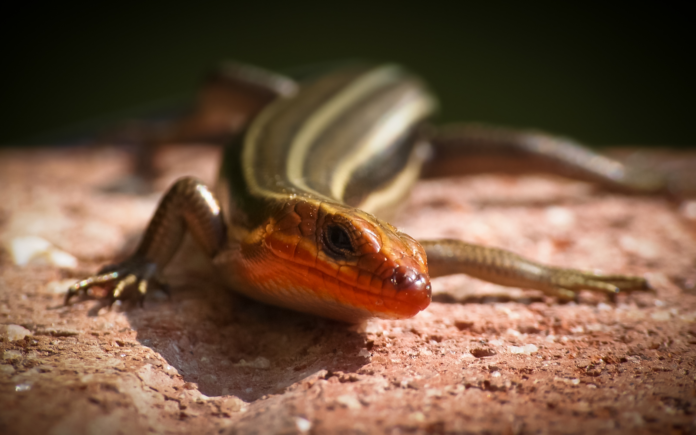Northern Michigan is home to a wide array of species, but only one lizard calls it home: the five-lined skink.
Five-lined skinks are elongated, slithery lizards with four short legs and no visible neck. These fleet-footed lizards can grow up to 8.5 inches long, and can be found in spots throughout the state from spring through early October, according to iNaturalist.com.
Creature features (American) Five-lined skink (Plestiodon fasciatus) Animalia/Chordata/Reptilia/Squamata/Scincidae/Plestiodon Size: 5-8.5 inches long Lifespan: Up to 6 years in the wild Habitat: Five-lined skinks prefer moist wooded or partially wooded areas with significant cover and abundant basking sites. Distribution: Their range extends in the north to southern Ontario, Michigan, and eastern New York. The western border is in Minnesota, Missouri, and eastern Kansas, Nebraska, Oklahoma, northern peninsular Florida, Mississippi, Louisiana, and Texas. Reproduction: Female skinks lay 15-18 eggs between May and July. Diet: While primarily an insectivore, lizards in captivity are known to also enjoy fruits and berries. See More Collapse
The lizards get their name from the five cream-colored stripes along the length of their body. These stripes are most evident in young skinks and adult females, while adult males are a more uniform brown and develop a reddish orange face during mating season.
Juveniles can easily be identified by their long, brilliant blue tails.
Five-lined skinks know how to get out of a jam — when threatened by a predator, this lizard can be observed using a peculiar strategy to make a quick getaway. The lizard detaches its own tail as a distraction for the predator, according to miherpatlas.org. The long, whip-like tail will continue writhing as the skink makes a break for cover.
Courtesy photo/Ken Thomas
Snakes, birds and other predators are often distracted by the flailing tail, and may be tempted to eat it in lieu of the fleeing lizard. Skinks have also been known to return to their shed tail in order to consume it, according to an entry on a-z-animals.com.
After losing its tail, a skink can grow another one, but it will never be as long or as vibrant as their original, according to iNaturalist.
Though furtive, five-lined skinks are fairly common lizards throughout North America, and their conservation status is listed as of least concern by the International Union for Conservation of Nature.
The state’s only other lizard, the six-lined racerunner is listed as threatened in Michigan, and is isolated to Tuscola County, according to iNaturalist.
Five-lined skinks can be found in wooded habitats, usually hiding under rotting wood and rock crevices, according to the University of Michigan museum of zoology. In more urban areas, they can find shelter in building foundations. Populations can also be found among driftwood piles on Great Lakes beaches.
Provided photo/Laura Perlick/U.S. Fish and Wildlife Service
The common five-lined skink’s diet consists primarily of a variety of arthropods: particularly spiders, crickets, beetles and other insects, according to animalia.bio.
Female five-lined skinks demonstrate a high level of parental care. Mother skinks will brood and guard their clutch of 14-18 eggs against small predators and will protect their young until one or two days after hatching, according to miherpatlas.org. Females also will lay their eggs in communal nests and help each other protect their eggs.
The range of five-lined skinks extends south from the Michigan’s Lower Peninsula, southern Ontario and eastern New York to northern Florida and west to Wisconsin, part of Michigan’s Upper Peninsula, Missouri and eastern regions of Kansas, Oklahoma and Texas, according to the University of Michigan website, which notes that isolated populations may also occur in northeastern Iowa, and west central Minnesota.




